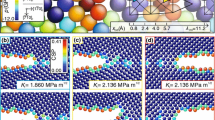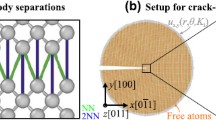Abstract
The phenomenon of interfacial fracture, as manifested by atomistic cleavage, debonding and dislocation emission provides a challenge for combined atomistic-continuum analysis. As a precursor for fully coupled atomistic-continuum simulation[1] of interfacial fracture, we focus here on the atomistic behavior within a nanoscopic core surrounding the crack tip. The inter-atomic potential under Embedded Atom Method is recapitulated to form an essential framework of atomistic simulation. The calculations are performed for a side-cracked disc configuration under a remoteK field loading. It is revealed that a critical loading rate defines the brittle-to-ductile transition of homogeneous materials. We further observe that the near tip mode mixity dictates the nanoscopic profile near an interfacial crack tip. A zigzag interface structure is simulated which plays a significant role in the dislocation emission from an interfacial crack tip, as will be explored in the second part of this investigation.
Similar content being viewed by others
References
Tan HL and Yang W. Atomistic/continuum simulation of interfacial fracture, Part II: Combined atomistic/dislocation/continuum simulation.Acta Mechanica Sinica, 1994, 10, 3
Daw MS and Baskes MI.Phys Rev, B, 1984, 29: 6443
Foils SM, Baskes MI and Daw MS.Phys Rev, B, 1986, 33: 7983
Baskes MI.Phys Rev, B, 1992, 46: 2727
Rice JR, Beltz GE and Sun Y. Peirels framework, for dislocation nucleation from a crack tip. in: Argon AS ed. Fundamentals of Fracture and Fatigue, Springer-Verlag, 1992, 1
Yang W, Tan HL and Guo TF. Evolution of Crack tip process zones IUTAM Symposium on Computational Mechanics of Material, Brown Univ, USA, June 1993
Clementi E and Roetti C. Atomic Data and Nuclear Data Tables, 1974, 14
Rose H, Smith JR, Guinea F and Ferrante J.Phys Rev, B, 1984, 29: 2963
Metropolis M, Rosenbluth AW, Rosenbluth MN, Teller AH and Teller E.J Chem Phys, 1953, 21: 1087
deCeilis B, Argon AS and Yip S.J Appl Phys, 1983, 54: 4864
Hsia KJ and Argon AS. Experimental study of micromechanisms of brittle-to-ductile transition of cleavage fracture in Si single crystals,Mater Sci Eng, A, 1994, 176
Yang W and Shih CF. Fracture along an interlayer,Int J Solids & Structs, 1994 (in press)
Author information
Authors and Affiliations
Additional information
The project supported by the National Natural Science Foundation of China
Rights and permissions
About this article
Cite this article
Honglai, T., Wei, Y. Atomistic/continuum simulation of interfacial fracture part I: Atomistic simulation. Acta Mech Sinica 10, 150–161 (1994). https://doi.org/10.1007/BF02486585
Received:
Issue Date:
DOI: https://doi.org/10.1007/BF02486585




